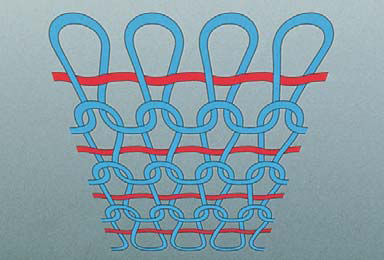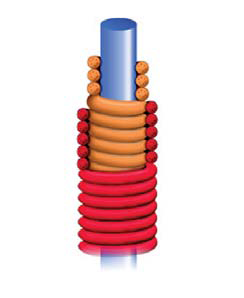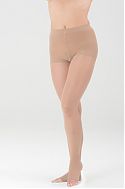The primary role of compression garments in lymphedema management is to maintain the reduction of the swelling achieved during the intensive treatment phase of Complete Decongestive Therapy (CDT). A high level of consistency in providing the appropriate compression is crucial in order to avoid re-accumulation of evacuated lymphedema fluid. This consistency is provided by high quality compression garments containing inlay threads, which are made of Lycra or rubber. These inlay threads are woven into the material in a continuous manner, thus providing the correct level of compression. It is important to realize that garments of lesser quality, known as over-the-counter (OTC) garments do not contain inlay threads and are not suitable for lymphedema management.
Sleeves and stockings are generally worn from first thing in the morning until night time, and although compression stockings are constructed of strong elastic and durable materials, they stretch out after about twelve hours of wearing. This is especially true in regions of increased stretch (knee, elbow) where garments wear out more than in other areas, which may result in pooling of edema fluid in those areas.
Compression garments act as a second layer of skin that provides the resistance the compromised skin no longer can; in order to maintain color, shape, elasticity and optimal therapeutic benefits of these garments, proper care is crucial.
Daily washing of compression garments helps them to restore and retain their elastic properties as well as removes perspiration, oils, dirt, bacteria and dead skin that accumulate inside the garment from normal wear. Frequent washing does not harm compression garments if done properly. However, the garments can be damaged easily, and its compressive qualities may be lost with even one tough rinse cycle, the wrong dryer setting or using the wrong cleaning agents.
Manufacturers such as Juzo, Medi, Jobst or Sigvaris include complete care instructions with their compression sleeves and stockings, which should always be followed for optimal care. Following is a list of items on specific guidelines in regard to proper care and washing, reflecting general consensus between various quality compression garment manufacturers:
Machine or hand-wash?
Garments (sleeves, stockings, pantyhose, gauntlets, face masks, vests, etc) may be machine or hand washed, depending on the preference of the user.
Daily washing is recommended, especially if lotions or creams are being used (moisturizing lotion can break down the fibers in compression garments and should be applied only at night when the garment is removed). When washing garments in a machine it is recommended to place the garment in a mesh laundry bag in order to protect the fabric during the washing cycle (the gentle cycle should be utilized).
Water temperature may range between cool and warm, but should not be colder than 86 degrees Fahrenheit, or warmer than 104 degrees Fahrenheit. Darker colored garments should be washed in cool water.
It is best to have more than one garment (one to wear, one to wash), which should be worn alternately to allow the elasticity to recover and to prolong their effectiveness
Tips for hand washing procedures:
1. Start by filling a bowl, bucket, sink, or small tub with water.
2. The compression garment should be dipped gently into the water to dampen.
3. Add a small amount of washing solution (see below).
4. Let the compression garment soak for a few minutes.
5. For better cleaning, gently rub the fibers of the compression garment together without stretching them excessively.
6. Then, empty the tub and refill with water – dip or rinse the clean compression garment thoroughly especially along the seams, to rid the garment of residual salts and oils from perspiration.
7. Gently squeeze the compression garment to remove excess water.
8. Refer to the drying options below
What kinds of washing solutions are appropriate?
Harsh cleaning agents, solvents, petroleum-based cleaners etc. can destroy the thin fibers of compression garments. Mild soaps or detergents should be used, free of bleach, chlorine, fabric softeners or other laundry additives.
Some manufacturers offer garment washing solutions, which are formulated to remove oil, body acids, and skin salts quickly and easily without damage to the fabric; using these specially-designed solutions is recommended and will help extend the life of elastic garments.
How should compression garments be dried after washing? Compression garments may be machine or air dried. If using a dryer, the dial should be set on a no-heat (maximum low-heat) air drying cycle because excessive heat exposure may weaken or even damage the elastic fibers of the garments. If silicone bands are present, the no-heat dryer setting will help to protect this material.
When garments are air-dried, it is important not to pull, squeeze or wring out the residual water from the garment excessively. Rolling up the compression garment in a towel and gently squeezing the towel before laying them out to dry, speeds up the drying process; garments should never be left rolled up in a towel.
Whether garments are line-dried, or laid flat to dry, exposure to direct sunlight should be avoided and the garment should be turned inside out. It is recommended to place a towel on a drying rack and lay the garment on top to dry. If hanging the garment directly on a rack or pole to drip dry, the weight of the water could stretch the stockings, causing them to fit improperly.
When should a compression garment be replaced?
The elastic fibers of a compression garment will break down with wear. While
proper care will increase the lifespan of garments, they will need to replaced about every six months or when the garment shows signs of wear that could adversely affect the compressive properties of the garment. As a general rule, if the garment no longer returns to its original shape after washing, has runs or holes in the material, no longer feels compressive, and if the garment becomes easy to put on, it probably needs to be replaced.
Additional Resources:
Step Up, Speak Out: Gloves and Hygiene
Dear Lymphedema Blog Reader – if you like the contents on this website, please help to keep it going. A great amount of work and research is necessary to provide you with up-to-date information on this site. Your donation supports these efforts and associated administrative costs. Surplus funds will be donated to Lymphedema/Lipedema-related charitable endeavors. Please donate using the “Donate Now” button on the right upper hand of this page – Thank You!
Join Lymphedema Guru, a Facebook page solely dedicated to inform about all things related to lymphedema – news, support groups, treatment centers, and much more


 Joachim Zuther, Lymphedema Specialist.
Joachim Zuther, Lymphedema Specialist. 




If the people that sale compression garments understands the point of of people using compressions for the dease Lymphedema (reducing fluid in the body parts). The prices of these garment should be more affordable, not everyone could afford a fur coat, chinchilla, a leather, or BMW OR JAGUAR. So for us people who need these garments to stay alive in this world shouldn’t the makers of these garments have a heart, and make the cost more affordable. Because if you have buy a custom compression garment such as myself for $400.00 plus dollar one pair is all I could afford withing the a six months time. For the price that the compresion garment sale we should be able to buy a seven day supply to wash every day.
I agree with Tonya. My Farrow wraps cost $415 and I know that I will need to replace them sometime. But I cannot afford the replacements. I take very good care of them, but really wish there were something more affordable.
I have been wearing compression garmentsfor 44 years on both my legs. I have always taken care of them exactly how you sid in the article and have been able to wear the garments for 6 months or longer before needed to replace them. I do have a question. Is there a garment fabric that will hold up in a pool? I excersise in a pool everyday. I wear an old pair of panty hose which last an aditional 3 months. Can I wear a lower compression in the water? Presently I wear compression 4 Elvarex. Should I switch to a rubber fabric in a lower compression?
Dear Blanche: Chlorine in the pool water will attack the garment fabric. We recommend to most patients wearing an older garment in the pool. The decision to switch compression classes should be made by your physician and/or lymphedema therapist
i have a question for the doctor. I just found this site Solaris that has a different alternative to elastic compression garments. i wanna try this out. I have had cdt and had the buildup of fluid gone but that was a couple of years ago I have crappy insurance and i hate the compression garments they hurt and itch and when the bunch her around my the ankle or down the bottom it hurts so bad and i end up snatching them off but these garment things on solaris seem like they may be more comfortable cause they are wraps and you can adjust daily for girth and etc. Do you know anything about them ? do they have to be prescribed ?
You do not necessarily need a prescription, but I would suggest you see your lymphedema therapist for advice on which Solaris item to use and to take appropriate measurements
Hello Joachim,
I like your blogs. Have you written anything about the need for compression bras or wraps for a woman right after surgery. I have heard that if a woman wears compression right after surgery, her risk of developing lymphedema later is reduced. Do you have any data that would support that?
Thank you for your thoughts,
Phyllis
Dear Phyllis: A University of Michigan study found that early diagnosis and treatment of breast cancer-related lymphedema can significantly reduce costs and the need for intensive rehabilitation. Their findings on UE lymphedema can certainly be applied to trunkal swelling as well: http://www.minbcnews.com/news/story.aspx?id=720061
Neither my surgeon or my oncologist mentioned anything about compression garments. The surgeon handed me a brochure on arm lymphedema. I have complained to the oncologist for 3 years, telling him I have truncal swelling. He measures my arm and tells me I don’t have lymphedema. Finally I was so fed up, I took my husband to the appointment. I insisted that I be allowed to go to a PT specializing in lymphedema and my husband did not let it go when he tried to brush it off once again. The onc. grudgingly let me go for therapy. Guess what, I have truncal lymphedema. The therapy and the exercises have helped a lot but as mentioned above about compression garments, the first ones I tried were too tight and drove me crazy. I found some light compression t-shirts that I can manage. Why aren’t oncologists more aware of lymphedema other than the arm? I’ve been to three different ones, hoping for help. I am a medical librarian and only by researching myself did I get information. What do you suggest for the truncal form after b/c surgery and sent. node biopsy?
Dear Kay – you may find this article informative: https://www.lymphedemablog.com/2011/10/05/lymphedema-affecting-the-breast-and-trunk/
Why is it so hard to get our garmets? The fitters seem to want more then the insurance company requires. The fitter wants the RX and a complete medical history from the doctors including the last office visit notes, which they say must contain the wording of lymphydema. The insurance company says the RX with the diagnosis code is all they need. I have had to change fitters for various reasons and it seems to be getting worse and worse with each fitter. Their delays are going to send my arm in to needing PT again which I do not have the time or money for. Any suggestions or experience with this?
Yes, as a fitter, we are required to have an order, your visit notes and the diagnosis of lymphedema. That is correct. As soon as we provide and bill for your garments , the insurance companies request all of this be submitted for review before they will process the claim.
Without the documentation , it will be denied.
I wish it was easier, but we are not in control of the process. We just live in the insurance world and have to abide by their rules. Please be patient with your fitter as they are just following the correct protocol!!!
Is a detergent such as All Free and Clear considered gentle enough? I bought some washing solution from Medi, but it’s pretty expensive if I have to use it daily. Thanks!
Nancy- it is always best to use the manufacturer recommended detergent – you may find this article interesting: https://www.lymphedemablog.com/2011/07/29/options-of-care-for-compression-garments/
I keep getting an infection in lymphedema arm. My doctor is questioning my garment. Is it possible that a compression garment can have some bacteria that is not cleared by washing? How do you sanitize the garments?
It is unlikely that your garment causes recurrent infections. However, just to be on the safe side, maybe you should purchase an additional sleeve.
Hello!
I ordered a new sleeve dyed a lovely medium intense blue. Within a day, my inner arm developed a nasty rash that resulted in a raging infection and a prescription for Cipro and Mometasone cream. The infection rash left me with a faitly lareg area of highly sensitive and red area on my inner arm at the elbow And, my arm swelled to even greater proportions requiring a month of CDT, with MLD and bandaging. Because my arm was still so sensitive, I again developed a rash when the bandaging started. I ended up in ER (again) and was given another Cipro prescription. The redness and sensitivity never healed totally during the whole month of CDT. Everyone’s opinion from the garment company to my health providers were sure the rash from the dye in the blue sleeve garment. I found out that I was not the only woman that experienced such problems with their compression garments.
By the way, a month of MLD and bandaging produced minimal improvement. Overall, after a month of bandaging, I lost only 1-1.5 cm. Further, the CDT sessions initially included the light touch MLD, but in the 2nd week, the PT began using much deeper stroking. B y the end of that week, my shoulder, back, side, and trunk were much bigger also! Especially my shoulder. So big that I could no longer wear most of my clothes, including my fairly new mastectomy bras. I mentioned this to the PT but initially she did not respond in any way. After persistent comments from me, she finally began MLD in my shoulder and back. But quite frankly, there is little improvement in the size. She has not addressed my severe truncal lymphedema. At 65, I look 7-8 months
O no! I have had 3 different therapist. One did very very light strokes and I got much better results. But she has a mental problem, never know when she is going to go off. 🙁 At 57 I look pregnant to dear!
[…] So – what is the best way to clean your garment? (The following information is from the ever-informative LymphedemaBlog.com) […]
A couple of questions: first to the other posters, Which insurance do you have that will help with compression garments? Second, Why might my new thigh high stocking creep down my leg and the knee darts move down below my knee, in addition to bunching behind my knee? Thanks!
Mara – you may want to try a compression stocking with a silicone border on top in order to prevent the stocking from sliding.